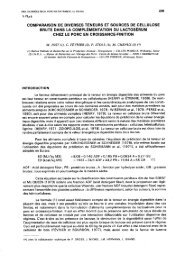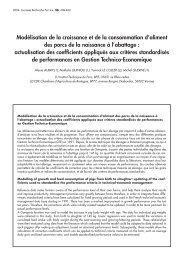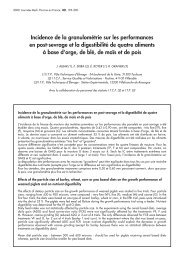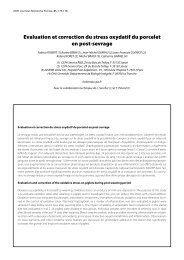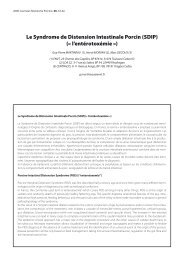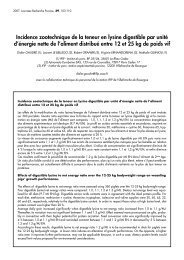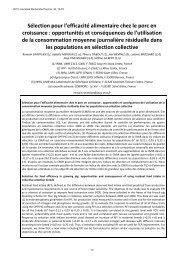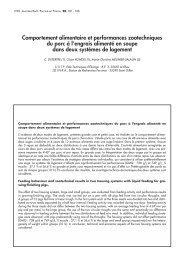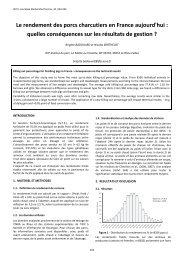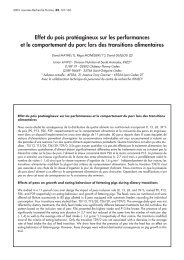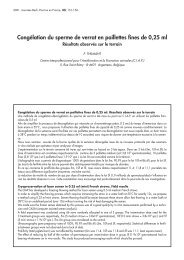Acquisition de l'immunité passive chez le porcelet : - Journées de la ...
Acquisition de l'immunité passive chez le porcelet : - Journées de la ...
Acquisition de l'immunité passive chez le porcelet : - Journées de la ...
You also want an ePaper? Increase the reach of your titles
YUMPU automatically turns print PDFs into web optimized ePapers that Google loves.
2005. Journées Recherche Porcine, 37, 443-448.<br />
<strong>Acquisition</strong> <strong>de</strong> l’immunité <strong>passive</strong> <strong>chez</strong> <strong>le</strong> porce<strong>le</strong>t :<br />
rô<strong>le</strong> <strong>de</strong> <strong>la</strong> quantité d’immunoglobulines ingérées et <strong>de</strong> <strong>la</strong> perméabilité intestina<strong>le</strong><br />
Jean LE DIVIDICH (1), Françoise THOMAS (1), Henri RENOULT (1) et Isabel<strong>le</strong> OSWALD (2)<br />
(1) INRA-UMRVP, 35590 Saint Gil<strong>le</strong>s<br />
(2) INRA Unité <strong>de</strong> Pharmacologie-Toxicologie, 180 Chemin <strong>de</strong> Tournefeuil<strong>le</strong>, 31931 Toulouse ce<strong>de</strong>x 9<br />
<strong>Acquisition</strong> <strong>de</strong> l’immunité <strong>passive</strong> <strong>chez</strong> <strong>le</strong> porce<strong>le</strong>t : rô<strong>le</strong> <strong>de</strong> <strong>la</strong> quantité d’immunoglobulines ingérées<br />
et <strong>de</strong> <strong>la</strong> perméabilité intestina<strong>le</strong><br />
Trente porcs nouveaux nés [Piétrain x (LWxLD)] sont utilisés pour déterminer l’effef <strong>de</strong> <strong>la</strong> quantité <strong>de</strong> colostrum consommé<br />
sur l’acquisition <strong>de</strong> l’immunité <strong>passive</strong> <strong>chez</strong> <strong>le</strong> porce<strong>le</strong>t. Intra portée, 5 porce<strong>le</strong>ts sont retirés <strong>de</strong> <strong>le</strong>ur mère dès <strong>la</strong> naissance<br />
et cathétérisés. A l’issue d’une récupération <strong>de</strong> 2 heures, ils sont alimentés au biberon pendant 27 heures avec un<br />
colostrum <strong>de</strong> composition connue à raison <strong>de</strong> 70, 140, 210, 280 ou 350 g/kg <strong>de</strong> poids vif initial (PVI)/24h. Des prises<br />
<strong>de</strong> sang sont effectuées à interval<strong>le</strong>s réguliers et <strong>le</strong>s concentrations en IgG déterminées. Juste avant <strong>le</strong> quinzième repas,<br />
c’est à dire 23 heures 30 après <strong>le</strong> premier repas, on administre aux porce<strong>le</strong>ts par tubage gastrique une solution saline<br />
<strong>de</strong> <strong>de</strong>xtran marqué à l’isothiocyanate <strong>de</strong> fluorescéine (FITC-D) pour déterminer l’effet <strong>de</strong> <strong>la</strong> quantité <strong>de</strong> colostrum<br />
consommé sur <strong>la</strong> perméabilité intestina<strong>le</strong>. Dans une étu<strong>de</strong> complémentaire, 4 porcs nouveaux nés sont utilisés pour<br />
déterminer <strong>la</strong> perméabilité intestina<strong>le</strong> initia<strong>le</strong>. Les concentrations p<strong>la</strong>smatiques en insuline sont éga<strong>le</strong>ment mesurées pour<br />
examiner l’implication possib<strong>le</strong> <strong>de</strong> l’hormone dans l’arrêt du transfert <strong>de</strong>s macromolécu<strong>le</strong>s. Indépen<strong>de</strong>mment du traitement,<br />
<strong>la</strong> concentration sérique en IgG agmente linéairement à raison <strong>de</strong> 0,27 ± 0,01 mg/ml par g <strong>de</strong> colostrum<br />
consommé au cours <strong>de</strong>s 9 premières heures d’alimentation pour atteindre un p<strong>la</strong>teau <strong>de</strong> va<strong>le</strong>ur variab<strong>le</strong> selon <strong>le</strong> traitement.<br />
Les va<strong>le</strong>urs d’IgG au p<strong>la</strong>teau sont semb<strong>la</strong>b<strong>le</strong>s (26,4 ± 0,66 mg/ml) <strong>chez</strong> <strong>le</strong>s porce<strong>le</strong>ts affectés aux traitements 280<br />
et 350 et supérieur à celui atteint par <strong>le</strong>s porce<strong>le</strong>ts affectés aux autres traitements. La va<strong>le</strong>ur maxima<strong>le</strong> <strong>de</strong> 26,4 ±<br />
0,66 mg d’IgG/ml, correspond à une ingestion <strong>de</strong> 110 g <strong>de</strong> colostrum/kg PVI. Quel que soit <strong>le</strong> traiement, un pic d’insuline<br />
est observé 14,50 h après <strong>le</strong> premier repas. Sa va<strong>le</strong>ur <strong>chez</strong> <strong>le</strong>s porce<strong>le</strong>ts au plus haut niveau <strong>de</strong> colostrum est <strong>de</strong><br />
trois fois supérieure à cel<strong>le</strong> obtenue <strong>chez</strong> ceux au plus faib<strong>le</strong> niveau. La transmission intestina<strong>le</strong> du FITC-D diminue fortement<br />
avec l’âge et avec <strong>la</strong> quantité <strong>de</strong> colostrum consommé. Au moment <strong>de</strong> <strong>la</strong> mesure, el<strong>le</strong> ne représente plus que 4,3%<br />
<strong>de</strong> sa va<strong>le</strong>ur mesurée à <strong>la</strong> naissance <strong>chez</strong> <strong>le</strong>s porce<strong>le</strong>ts <strong>de</strong>s traitements 210 ou plus. El<strong>le</strong> est plus é<strong>le</strong>vée <strong>chez</strong> <strong>le</strong>s porce<strong>le</strong>ts<br />
du traiement 70, el<strong>le</strong> ne représente toutefois que 27,0 % <strong>de</strong> sa va<strong>le</strong>ur initia<strong>le</strong>. La signification d’une concentration satifaisante<br />
en IgG est discutée en re<strong>la</strong>tion avec <strong>la</strong> survie et l’acquisition d’une immunité satisfaisante.<br />
<strong>Acquisition</strong> of <strong>passive</strong> immunity in the pig<strong>le</strong>t: effects of the amount of ingested immunoglobulins<br />
and of intestinal permeability.<br />
Thirty new-born pigs were used to examine the effects of colostrum intake on the acquisition of <strong>passive</strong> immunity. Within<br />
a litter, five pigs were removed from the sow just at birth. They were catheterized and after a recovery of two hours,<br />
bott<strong>le</strong>-fed colostrum of known composition for 27 hours at the rate of 70, 140, 210, 280 or 350 g/kg initial body<br />
weight (IBW)/24h. Blood samp<strong>le</strong>s were taken to <strong>de</strong>termine serum IgG and p<strong>la</strong>sma insulin concentrations, to examine<br />
the possib<strong>le</strong> implication of the hormone in the gut closure. Prior to the 15 th feeding, i.e., at 23.5 h after the 1 st feeding,<br />
pig<strong>le</strong>ts were intra-gastrically administrated fluorescein isothiocyanate <strong>la</strong>bel<strong>le</strong>d <strong>de</strong>xtran (FITC-D) to assess the intestinal<br />
permeability to macromo<strong>le</strong>cu<strong>le</strong>s. Initial intestinal permeability was also examined at birth on four additional pigs.<br />
Irrespective of treatment, serum IgG concentrations increased linearly at the rate of 0.27 ± 0.01 mg / ml per g colostrum<br />
intake during the first 9 hours after the first feeding, and p<strong>la</strong>teaued afterwards. Values obtained at the p<strong>la</strong>teau<br />
were <strong>de</strong>pen<strong>de</strong>nt on the amount of IgG ingested. Pig<strong>le</strong>ts on treatments 280 and 350 had simi<strong>la</strong>r serum IgG concentrations<br />
at the p<strong>la</strong>teau (26.4 ± 0.66 mg/ml). This value correspon<strong>de</strong>d to 110 g colostrum/kg IBW. Regard<strong>le</strong>ss of the treatment,<br />
p<strong>la</strong>sma insulin concentrations peaked at 14.50 h after the first feed was given, with the <strong>le</strong>vel attained in pigs on<br />
treatment 350 being about 3 times higher than that attained in pigs on treatment 70. Intestinal transmission of FITC-D<br />
<strong>de</strong>creased with age and was <strong>de</strong>pen<strong>de</strong>nt on the <strong>le</strong>vel of colostrum intake. At the time of measurement, it was reduced to<br />
an average of 4.3 and 27.0% of its initial value in pigs on treatments 210, 280 and 350, and 70, respectively. The<br />
significance of the maximal serum IgG concentration is discussed in re<strong>la</strong>tion to survival and the acquisition of an a<strong>de</strong>quate<br />
<strong>passive</strong> immunity.
444<br />
INTRODUCTION<br />
Le porce<strong>le</strong>t naît complètement dépourvu <strong>de</strong> protection immunitaire<br />
(SALMON, 1984). La consommation <strong>de</strong> colostrum<br />
maternel, dans <strong>le</strong>s quelques heures qui suivent <strong>la</strong> naissance<br />
lui procure une immunité systémique (AUMAÎTRE et SEVE,<br />
1978 ; ROOKE et BLAND, 2002). Une consommation insuffisante<br />
<strong>de</strong> colostrum (énergie) est une cause majeure <strong>de</strong> <strong>la</strong><br />
mortalité néonata<strong>le</strong> provoquée par <strong>la</strong> sous-alimentation et<br />
l’hypothermie. Mais el<strong>le</strong> peut aussi conduire à un transfert<br />
insuffisant d’immunoglobulines maternel<strong>le</strong>s au nouveau-né<br />
résultant en une protection immunitaire insuffisante. Les porce<strong>le</strong>ts<br />
qui meurent à l’issue <strong>de</strong> 4-5 jours d’al<strong>la</strong>itement, présentent<br />
en effet, peu <strong>de</strong> temps après <strong>la</strong> naissance <strong>de</strong>s teneurs<br />
en immunoglobulines G (IgG) plus faib<strong>le</strong>s que <strong>le</strong>s survivants<br />
(HENDRIX et al, 1978 ; BLECHA et KELLEY, 1981 ; KOBLA-<br />
SA et al, 1981). L’acquisition d’une bonne immunité systémique<br />
semb<strong>le</strong> donc avoir une importance primordia<strong>le</strong> pour<br />
<strong>la</strong> survie et <strong>le</strong> développement <strong>de</strong>s porce<strong>le</strong>ts.<br />
L’évolution du profil en IgG sérique a été décrite <strong>chez</strong> <strong>le</strong> porce<strong>le</strong>t<br />
al<strong>la</strong>ité (JENSEN et PEDERSEN, 1979 ; KLOBASA et al,<br />
1981 ; GOMEZ et al, 1998). Cependant, à notre connaissance,<br />
aucune étu<strong>de</strong> ne rapporte <strong>le</strong>s re<strong>la</strong>tions entre ce profil<br />
et <strong>la</strong> quantité <strong>de</strong> colostrum consommé. En moyenne, cel<strong>le</strong>-ci<br />
est <strong>de</strong> 315 à 340g/kg <strong>de</strong> poids vif (LE DIVIDICH et al,<br />
1998) au cours <strong>de</strong>s premières 24 heures <strong>de</strong> vie. Mais, en<br />
réalité, el<strong>le</strong> est très variab<strong>le</strong> ainsi que l’atteste <strong>le</strong> gain <strong>de</strong><br />
poids <strong>de</strong>s porce<strong>le</strong>ts variant au sein <strong>de</strong> <strong>la</strong> portée au cours <strong>de</strong><br />
cette même pério<strong>de</strong> entre -350 et + 350g (LE DIVIDICH et al,<br />
2004), suggérant que <strong>la</strong> quantité d’IgG transférées au porce<strong>le</strong>t<br />
est aussi très variab<strong>le</strong>. Dans cette étu<strong>de</strong>, nous examinons<br />
<strong>le</strong>s effets <strong>de</strong> <strong>la</strong> quantité colostrum consommé sur <strong>le</strong> profil<br />
en IgG du porce<strong>le</strong>t au cours <strong>de</strong> sa première journée <strong>de</strong><br />
vie.<br />
1. MATÉRIELS ET MÉTHODES<br />
1.1. Animaux<br />
Trente porcs nouveaux nés (Piétrain x LW-LD) issus <strong>de</strong><br />
6 truies sont utilisés. Les mises bas sont surveillées et dès <strong>le</strong>ur<br />
naissance 5 porce<strong>le</strong>ts par portée sont isolés <strong>de</strong> <strong>le</strong>ur mère,<br />
séchés et p<strong>la</strong>cés à 32-33°C. Un cathéter est introduit dans<br />
une veine jugu<strong>la</strong>ire sous anesthésie généra<strong>le</strong>. A l’issue d’environ<br />
2 heures <strong>de</strong> récupération, <strong>le</strong>s porce<strong>le</strong>ts sont à nouveau<br />
pesés (poids vif initial, PVI) et affectés, intra-portée selon <strong>le</strong>ur<br />
PVI, à l’un <strong>de</strong>s traitements suivants : 70, 140, 210, 280 ou<br />
350g <strong>de</strong> colostrum/kg PVI/24 heures. Ils sont p<strong>la</strong>cés en<br />
cage individuel<strong>le</strong> (0,50 x 0,41 x 0,41 m) dans une sal<strong>le</strong> à<br />
température et venti<strong>la</strong>tion contrôlées. A l’issue <strong>de</strong> l’expérience,<br />
<strong>le</strong>s porce<strong>le</strong>ts sont sacrifiés afin d’examiner l’influence <strong>de</strong><br />
<strong>la</strong> quantité <strong>de</strong> colostrum consommé sur <strong>le</strong> développement <strong>de</strong><br />
l’appareil digestif (données non présentées).<br />
1.2. Alimentation<br />
Trois pools <strong>de</strong> colostrum sont obtenus à partir <strong>de</strong> plusieurs<br />
truies par traite manuel<strong>le</strong> 1-2 heures (CO), environ<br />
24 heures (C24) et 36 heures après <strong>la</strong> fin <strong>de</strong> <strong>la</strong> parturition.<br />
Afin <strong>de</strong> mimer l’évolution <strong>de</strong> <strong>la</strong> composition du colostrum au<br />
cours du premier jour après <strong>la</strong> mise bas, un colostrum intermédiaire<br />
(C12) est obtenu en mé<strong>la</strong>ngeant volume à volume<br />
du C0 et du C24. De même un C30 est obtenu en mé<strong>la</strong>ngeant<br />
du C24 et du C36 (2/1). Les divers colostrum sont<br />
ensuite répartis en portions <strong>de</strong> 70-100 g et congelés. La<br />
congé<strong>la</strong>tion conserve en effet <strong>le</strong>s qualités nutritionnel<strong>le</strong>s et<br />
immunes du colostrum (KLOBASA et al, 1998). Les porce<strong>le</strong>ts<br />
sont alimentés au biberon à interval<strong>le</strong> d’une heure pendant<br />
<strong>le</strong>s 6 premières heures et ensuite toute <strong>le</strong>s 2 heures pendant<br />
20 heures. Au total, <strong>le</strong>s porce<strong>le</strong>ts reçoivent 17 repas : 7 <strong>de</strong><br />
C0 suivis <strong>de</strong> 4 <strong>de</strong> C12, 4 <strong>de</strong> C24 et 2 <strong>de</strong> C30. Avant<br />
chaque distribution, <strong>le</strong> colostrum est réchauffé à 37°C. Le<br />
volume <strong>de</strong> chaque repas est doublé lorsque l’interval<strong>le</strong> entre<br />
chaque repas passe à 2 heures. La quantité <strong>de</strong> colostrum<br />
consommé est déterminée par pesée (± 0,1g) du biberon<br />
avant et après chaque repas. La composition <strong>de</strong>s colostrum<br />
est présentée au tab<strong>le</strong>au 1. Pour déterminer l’effet <strong>de</strong> <strong>la</strong><br />
quantité <strong>de</strong> colostrum consommé sur <strong>la</strong> perméabilité intestina<strong>le</strong>,<br />
chaque porce<strong>le</strong>t reçoit par tubage gastrique, en même<br />
temps que <strong>le</strong> 15 ème repas, une solution saline <strong>de</strong> <strong>de</strong>xtran<br />
(20mg/ml) marqué à l’isothiocyanate <strong>de</strong> fluorescéine<br />
(FITC-D 70, PM : 70000 dalton), à raison <strong>de</strong> 10ml/kg <strong>de</strong><br />
poids corporel. Dans une étu<strong>de</strong> complémentaire, 4 porcs<br />
nouveaux nés sont utilisés pour déterminer <strong>la</strong> perméabilité<br />
intestina<strong>le</strong> initia<strong>le</strong>. Le FITC-D est administré, lors du 1 er repas,<br />
<strong>de</strong> <strong>la</strong> même manière que précé<strong>de</strong>mment. Les porce<strong>le</strong>ts sont<br />
nourris toutes <strong>le</strong>s heures pendant 9 heures à raison <strong>de</strong> 250g<br />
<strong>de</strong> colostrum / kg PVI / 24 heures.<br />
1.3. Prises <strong>de</strong> sang et analyses<br />
El<strong>le</strong>s sont effectuées environ 30 mn avant <strong>le</strong> 1 er , 2 ème , 3 ème ,<br />
5 ème , 8 ème , 11 ème et 15 ème repas, puis 90 min après <strong>le</strong> <strong>de</strong>rnier<br />
repas. Après coagu<strong>la</strong>tion d’une partie <strong>de</strong> chaque échantillon,<br />
<strong>le</strong> sérum est séparé par centrifugation, pré<strong>le</strong>vé et<br />
congelé. Une autre partie pré<strong>le</strong>vée sous héparine est rapi<strong>de</strong>ment<br />
centrifugée et <strong>le</strong> p<strong>la</strong>sma congelé. Sur <strong>le</strong>s 4 animaux<br />
complémentaires, <strong>de</strong>s prises <strong>de</strong> sang sont aussi effectuées<br />
environ 30 min avant <strong>le</strong>s repas 2 à 9 et 30 min après <strong>le</strong> <strong>de</strong>rnier<br />
repas. L’analyse <strong>de</strong>s colostrum est effectuée selon <strong>le</strong>s<br />
métho<strong>de</strong>s précé<strong>de</strong>mment décrites (LE DIVIDICH et al, 1991).<br />
Les IgG colostraux et sériques sont déterminés par <strong>la</strong> métho<strong>de</strong><br />
ELISA selon PINTON et al, (2004) et <strong>le</strong> FITC-D par fluorimétrie<br />
(WESTRÖM et al, 1984). Enfin, sur <strong>le</strong>s porce<strong>le</strong>ts <strong>de</strong>s<br />
lots 70, 210 et 350, l’insuline p<strong>la</strong>smatique est déterminée<br />
par RIA à l’ai<strong>de</strong> d’un kit CIS bio International-Oris (France)<br />
afin <strong>de</strong> vérifier l’implication possib<strong>le</strong> <strong>de</strong> cette hormone dans<br />
l’arrêt du transfert intestinal <strong>de</strong>s macromolécu<strong>le</strong>s (SVEND-<br />
SEN et al, 1986).<br />
Tab<strong>le</strong>au 1 - Composition chimique <strong>de</strong>s colostrum<br />
Colostrum<br />
CO C12 C24 C30<br />
Humidité, % 76,5 77,0 77,7 76,4<br />
Protéines, (Nx6,38) % 14,1 12,2 10,2 9,1<br />
Lipi<strong>de</strong>s, % 5,6 6,6 7,6 9,2<br />
Lactose, % 3,2 3,4 3,5 4,1<br />
Energie brute, kJ/g 6,1 6,0 6,2 6,6<br />
IgG, g ‰ 66,0 42,7 22,4 16,2
445<br />
1.4. Analyse statistique<br />
Les différences <strong>de</strong> concentrations en IgG et en insuline sont<br />
testées par <strong>la</strong> métho<strong>de</strong> <strong>de</strong>s “mesures répétées”. En outre,<br />
nous avons rapporté <strong>le</strong>s concentrations sériques en IgG <strong>de</strong>s<br />
porce<strong>le</strong>ts en fonction <strong>de</strong> <strong>la</strong> quantité cumulée <strong>de</strong> colostrum<br />
ingéré. A l’exception du lot 70, ces re<strong>la</strong>tions sont décrites<br />
comme une fonction linéaire-p<strong>la</strong>teau avec <strong>la</strong> même pente et<br />
un p<strong>la</strong>teau commun aux traitements 280 et 350. L’analyse<br />
est effectuée à l’ai<strong>de</strong> <strong>de</strong> <strong>la</strong> procédureNLIN du logiciel SAS<br />
(1990).<br />
2. RÉSULTATS<br />
Le poids moyen initial <strong>de</strong>s porce<strong>le</strong>ts <strong>de</strong>s 5 groupes est <strong>de</strong><br />
1416 (± 59) g (tab<strong>le</strong>au 2). Le gain <strong>de</strong> poids (Y, g) augmente<br />
<strong>de</strong> manière linéaire (P
446<br />
étant plus <strong>de</strong> 3 fois plus é<strong>le</strong>vée (70,0 (± 59) vs 20,7 (± 59),<br />
P < 0,01) que cel<strong>le</strong> atteinte par <strong>le</strong> groupe 70. Parallè<strong>le</strong>ment,<br />
<strong>la</strong> glycémie (données non présentées) augmente d’une va<strong>le</strong>ur<br />
initia<strong>le</strong> <strong>de</strong> 0,56 g/l jusqu’à un p<strong>la</strong>teau atteint 14h30 après<br />
<strong>le</strong> premier repas. Les va<strong>le</strong>urs au p<strong>la</strong>teau <strong>chez</strong> <strong>le</strong>s porce<strong>le</strong>ts<br />
<strong>de</strong>s groupes 70, 210 et 350 sont respectivement 1,10<br />
(± 0,10), 1,25 (± 0,07) et 1,48 (± 0,05) g/l. Les différences<br />
sont toutes significatives (P < 0,05).<br />
2.3. Transfert du FITC-D<br />
Chez <strong>le</strong> nouveau-né, <strong>la</strong> concentration sérique du FITC-D<br />
augmente <strong>de</strong> manière curvilinéaire (P
447<br />
JACOBSEN et al, 2002). Il est alors possib<strong>le</strong> que <strong>le</strong>s différences<br />
<strong>de</strong> concentrations maxima<strong>le</strong>s d’IgG <strong>chez</strong> <strong>le</strong>s porce<strong>le</strong>ts<br />
soient dues à <strong>de</strong>s différences <strong>de</strong> concentrations initia<strong>le</strong>s <strong>de</strong>s<br />
colostrums en IgG. Dans notre étu<strong>de</strong>, el<strong>le</strong>s sont simi<strong>la</strong>ires à<br />
cel<strong>le</strong>s <strong>de</strong> 58 à 70 mg/ml rapportées par JENSEN et PEDER-<br />
SEN (1979), BLAND et al, (2003) et LE DIVIDICH et al,<br />
(2004), mais plus faib<strong>le</strong>s que cel<strong>le</strong>s <strong>de</strong> 86 à 96 mg/ml rapportées<br />
par BOURNE (1969) et KLOBASA et al (1987).<br />
Selon certains auteurs (HENDRIX et al, 1978 ; KOBLASA et<br />
al, 1981), <strong>le</strong>s porce<strong>le</strong>ts qui meurent avant <strong>le</strong> sevrage ont <strong>de</strong>s<br />
taux d’IgG sériques <strong>de</strong> 10 à 50 % inférieurs à ceux <strong>de</strong>s survivants.<br />
On peut alors se <strong>de</strong>man<strong>de</strong>r dans quel<strong>le</strong> mesure <strong>la</strong><br />
concentration maxima<strong>le</strong> en IgG au p<strong>la</strong>teau correspond à une<br />
immunité <strong>passive</strong> satisfaisante. Chez <strong>le</strong> veau, une concentration<br />
éga<strong>le</strong> ou supérieure à 15 mg/ml est considérée comme<br />
suffisante pour assurer une bonne protection contre <strong>le</strong>s infections<br />
(PERINO et al, 1995 ; WITTUM et PERINO, 1995). Chez<br />
<strong>le</strong>s porce<strong>le</strong>ts, COALSON et LECCE (1973) suggèrent qu’“une<br />
heure <strong>de</strong> tétée d’un colostrum <strong>de</strong> bonne qualité immune” est<br />
suffisante pour <strong>le</strong>ur procurer une immunité <strong>passive</strong> satisfaisante<br />
correspondant à 15-17 mg IgG/ml. Selon l’équation 2, ce<br />
niveau d’IgG peut être acquis par une ingestion <strong>de</strong> seu<strong>le</strong>ment<br />
70 g <strong>de</strong> colostrum, <strong>de</strong> bonne qualité immune/kg PVI (soit<br />
98 g pour <strong>de</strong>s porce<strong>le</strong>ts pesant 1,400 kg, en moyenne) dans<br />
<strong>le</strong>s quelques heures suivant <strong>la</strong> naissance. Mais, à cette quantité<br />
<strong>de</strong> colostrum consommé correspond, d’après l’équation 1,<br />
un gain <strong>de</strong> poids négatif (-40 g) <strong>de</strong>s porce<strong>le</strong>ts entre <strong>la</strong> naissance<br />
et 24 heures ce qui constitue un facteur <strong>de</strong> risque pour<br />
<strong>le</strong>ur survie (LE DIVIDICH et al, 2004). En d’autres termes, l’acquisition<br />
d’une immunité <strong>passive</strong> satisfaisante n’est pas une<br />
garantie <strong>de</strong> survie <strong>de</strong>s porce<strong>le</strong>ts. D’ail<strong>le</strong>urs, selon TYLER et al,<br />
(1990), <strong>le</strong> taux d’IgG entre 48 et 60 heures d’âge ne serait<br />
qu’un médiocre prédicteur <strong>de</strong> <strong>la</strong> survie <strong>de</strong>s porce<strong>le</strong>ts. Ceci est<br />
aussi illustré par <strong>le</strong>s résultats <strong>de</strong> DEVILLERS (2004) montrant<br />
que <strong>le</strong>s porce<strong>le</strong>ts qui meurent dans <strong>le</strong>s trois premiers jours <strong>de</strong><br />
vie ont, à 24h d’âge, un taux d’IgG acceptab<strong>le</strong>, soit<br />
15,4mg/ml <strong>de</strong> sérum, mais ne consomment, en moyenne, que<br />
70 g <strong>de</strong> colostrum. Selon cet auteur, une consommation d’environ<br />
200 g <strong>de</strong> colostrum serait nécessaire pour fournir suffisamment<br />
d’énergie pour <strong>la</strong> survie <strong>de</strong>s porce<strong>le</strong>ts. Mais, une<br />
ingestion <strong>de</strong> colostrum en quantité suffisante pour couvrir <strong>le</strong><br />
besoin en énergie du porce<strong>le</strong>t, lui apporterait éga<strong>le</strong>ment suffisamment<br />
d’immunoglobulines pour une protection immunitaire<br />
satisfaisante.<br />
Remerciements à Y. Lebreton pour <strong>la</strong> préparation chirurgica<strong>le</strong><br />
<strong>de</strong>s porce<strong>le</strong>ts.<br />
RÉFÉRENCES BIBLIOGRAPHIQUES<br />
• AUMAÎTRE A., SÈVE B., 1978. Ann. Rech. Vet., 9, 181-192.<br />
• BATE, L.A. HACKER R.R., 1985. Can. J Anim. Sci., 65, 77-85.<br />
• BESSER T.E., GARMEDIA A.E., McGUIRE T.C., GAY C.C., 1985. J Dairy Sci., 68, 2033-2037.<br />
• BLAND I.M., ROOKE J.A., BLAND V.C., SINCLAIR A.G., EDWARDS S.A., 2003. Anim. Sci. 77, 277-286.<br />
• BLECHA F., KELLEY K.W., 1981. J. Anim. Sci., 52, 594-600.<br />
• BOURNE F.J., 1969. Anim. Prod., 11, 337-343.<br />
• COALSON J.A., LECCE J.G., 1973. J. Anim. Sci. 36, 381-385.<br />
• DEVILLERS N., 2004. Variabilité <strong>de</strong> <strong>la</strong> production colostra<strong>le</strong> <strong>chez</strong> <strong>la</strong> truie. Origine et conséquences pour <strong>la</strong> survie du porce<strong>le</strong>t. Thèse <strong>de</strong><br />
Doctorat <strong>de</strong> l’Université <strong>de</strong> Rennes (179 p).<br />
• DONOVAN T.S., DRITZ S.S., 2000. JAVMA., 217, 79-80.<br />
• GOMEZ, G.G., PHILIPS, O., GOFORD, R.G., 1998. J. Anim. Sci. 76, 1-7.<br />
• HENDRIX W.F., KELLEY K.W. GASKINS C.T., HINRICHS D.J., 1978. J. Anim. Sci., 1281-1286.<br />
• JACOBSEN H., SANGILD P.T., SCHMIDT M., HOLN P., GREVE T., CALLENSEN H., 2002. Anim. Reprod. Sci., 70, 1-11.<br />
• JENSEN P.T., PEDERSEN K.B., 1979. Acta vet. Scand. 20, 60-72.<br />
• JENSEN A., R., ELNIF J., BURRIN D.G., SANGILD P.T., 2001. J Nutr., 131, 3259-3265.<br />
• KOBLASA F., WERHAHN E., BUTHER JE., 1981. Res. Vet. Sci., 31, 195-206.<br />
• KOBLASA F., WERHAHN E., BUTLER J.E., 1987. J Anim. Sci., 65, 1458-1466.<br />
• KOBLASA F., GOEL M.C., WERHAHN E., 1998. J Anim. Sci., 76, 923-926.<br />
• LEARY H.L., LECCE J.G., 1978. Biol. Neonate, 34, 174-176.<br />
• LECCE J.G., MORGAN D.G, 1962. J. Nutr., 78, 263-268.<br />
• LE DIVIDICH J., ESNAULT Th., LYNCH B., HOO-PARIS R., CASTEX Ch. PEINIAU J. 1991., J Anim. Sci., 79, 2480-2488.<br />
• LE DIVIDICH J., NOBLET J., HERPIN P., van MILGEN J., QUINIOU N., 1998. In: Progress in Pig Science, Wiseman J., Var<strong>le</strong>y M.A., Charlick<br />
J.P. (Eds), Nottingham University Press, pp 229-263.<br />
• LE DIVIDICH J., MARTINEAU G.P., THOMAS, F., DEMAY H., RENOULT H., HOMO Ch., BOUTIN D., GAILLARD L., SUREL Y., BOUETARD<br />
R., MASSARD M., 2004. Journées Rech. Porcine, 36, 451-456.<br />
• MACHADA-NETO R., GRAVES C.N., CURTIS, S.E., 1987. J Anim. Sci., 65, 445-455.<br />
• MURATA H., NAMIOKA S., 1977. J. Comp. Path., 87, 431-439.<br />
• PERINO L.J., WITTUM T.E., ROSS G.S. 1995. Am. J. Vet .Res. 56, 114-118.<br />
• PINTON P., ROYER E., ACCENSI F., MARIN D., GUELFI J.F., BOURGES-ABELLA N., GRANIER R., GROSJEAN F., OSWALD I.P., 2004.<br />
Journées Rech. Porcine, 36, 301-308.<br />
• ROOKE J.A., BLAND I.M., 2002. Livest. Prod. Sci., 78, 12-23.<br />
• SALMON H., 1984. Reprod. Nutr. Dev., 24, 197-206.<br />
• SVENDSEN L.S., WESTRÖM BR., SVENDSEN J., OHLSSON BG., EKMAN R., KARLSSON BW., 1986. J. Pediatr. Gastroenterol. Nutr. 5,<br />
299-304.<br />
• TYLER J.W., CULLOR J., THURMOND M.C., DOUGLAS V.L., PARKER K.M., 1990. Am. J. Vet. Res., 51, 1400-1406.<br />
• WERHAHN E., KLOBASA F., BUTLER J.E., 1981. Vet. Immunol. Immunopathol. 2, 35-51.<br />
• WESTRÖM BR., SVENDSEN J., OHLSSON BG., TAGESSON C. KARLSSON BW., 1984. Biol. Neonate, 46, 20-26.<br />
• WITTUM Th.E., PERINO L.J., 1995. Am. J. Vet .Res., 56, 1149-1154.



